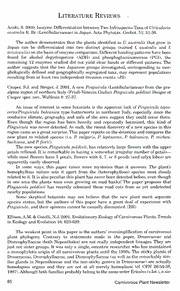Table Of ContentLiterature Reviews
Araki, S. 2000, Isozyme Differentiation between Two Infraspecies Taxa of Utricularia
australis R. Br. (Lentibulariaceae) in Japan. Acta Phytotax. Geobot. 51: 31-36.
The author demonstrates that the plants identified as U. australis that grow in
Japan can be differentiated into two distinct groups (named f. australis and f.
tenuicaulis) on the basis of isozyme comparison. Different banding patterns have been
found for alcohol degydrogenase (ADH) and phosphoglucoisomerase (PGI), the
remaining 12 enzymes studied did not yield clear bands or different patterns. The
author suggests that the two Japanese groups investigated, corresponding to mor¬
phologically defined and geographically segregated taxa, may represent populations
resulting from at least two independent invasion events. (JS)
Casper, S.J. and Steiger, J. 2001, A new Pinguicula (Lentibulariaceae) from the pre-
alpine region of northern Italy (Friuli-Venezia Giulia): Pinguicula poldinii Steiger et
Casper spec, nov., Wulfenia 8: 27-37.
An issue of interest to some botanists is the apparent lack of Pinguicula lepto-
ceras/Pinguicula balcanica type butterworts in northeast Italy, especially since the
conducive climate, geography, and soils of the area suggest they could occur there.
Even though the region has been heavily and repeatedly botanized, this kind of
Pinguicula was never detected. As such, the recent discovery of a new species in this
region came as a great surprise. This paper reports on the detection and compares the
new plant to related species (i.e. P vulgaris, P. leptoceras, P. balcanica, P reichen-
bachiana, and P. fiorii).
The new species, Pinguicula poldinii, has relatively large flowers with the upper
petals reflexed. It is remarkable in having a somewhat irregular number of petals—
while most flowers have 5 petals, flowers with 6, 7, or 8 petals (and calyx lobes) are
apparently easily observed.
In some ways, this paper raises more mysteries than it answers. The plant’s
homophyllous nature sets it apart from the (heterophyllous) species most closely
related to it. It is also peculiar this plant has never been detected before, even though
in one area the plants were even growing on road banks! The paper proposes that
Pinguicula poldinii has recently colonized these road cuts from as yet undetected
nearby populations.
Some skeptical botanists may not believe that the new plant merit separate
species status, but the authors of this paper have a great deal of experience with
Pinguicula, and their opinions cannot be casually discounted. (BR)
Ellison, A.M. & Gotelli, N.J. 2001, Evolutionary Ecology of Carnivorous Plants. Trends
in Ecology and Evolution 16: 623-629.
The weakest point in this paper is the authors’ oversimplification of carnivorous
plant phylogeny. Contrary to statements made in the paper, Droseraceae and
Dioncophyllaceae (both Nepenthales) are not really independent lineages. They are
just not sister groups. It was only a single, eccentric researcher who has maintained
a monophyletic origin of all carnivorous plants until the 1980s. The sticky glands of
Droseraceae, Drorophyllaceae, and Dioncophyllaceae (as well as the remarkably sim¬
ilar glands in Nepenthaceae and the non-sticky genera in Droseraceae) are actually
homologous organs and they are not at all merely homoplasic (cf. CPN 26:34-38,
1997). Although both families probably belong to the same order Ericales (s.lat.), a sis-
85 Carnivorous Plant Newsletter
ter group relationship between Sarraceniaceae and Roridulaceae is by no means sup¬
ported unanimously by all gene sequence comparisons (only rbcL alignments suggest
such a close relationship). The proximity of Byblidaceae to Solanaceae was caused by
poor taxonomic sampling in the first (1993) genetic analysis. More recent data sug¬
gest a placement of Byblidaceae in Scrophulariales, not in Solanales. Cephalotaceae
are not placed in Geraniales but in Oxalidales, which is a separate lineage. It is not
sure if Roridulaceae are ancestral to Sarraceniaceae (it is not even clear if the two are
sister groups), and therefore it cannot be stated that adhesive traps are “simpler”
(from a phylogenetic perspective) than pitchers in Ericales.
Great emphasis is laid on a weak hypothesis that “most” carnivorous plants are
restricted to well-lit, nutrient-poor, waterlogged habitats. This generalization and the
largest part of the academic speculation derived from it are bound to collapse if but-
terworts (most of which dwell in shaded situations) or epiphytes (that do not inhabit
permanently waterlogged places) are considered. (JS)
Komiya, S., Toyama, M., Okita, S. & Shibata, C. 2001, Utricularia macrorhiza Le
Conte is Distributed in Northern Japan. Journal of Japanese Botany 76:120-122 (in
Japanese)
Unfortunately, no English abstract is provided in this paper but the distribution
map on p. 121 shows that most probably the plants treated as different Japanese
forms of U. australis in Araki’s paper discussed above are actually two different
species, viz. U. australis proper and the well-known north American and northeast
Asian U. macrorhiza. The latter species has not been recorded from Japan before,
probably because it had been confused with U. australis so far (even by respected
authorities such as Peter Taylor). Chorologically a southward range extension of U.
macrorhiza to northern Japan is plausible, and the present interpretation may be the
solution of a series of problems concerning these plants. In this light all records of
allegedly fertile specimens of “U. australis” should be re-examined very carefully to
determine if they really belong to this species. (JS)
5th International Carnivorous Plant Conference:
Call for Proposals
Dear fellow carnivorous plant enthusiasts,
Now that the 4th International Carnivorous Plant Conference at Tokyo has suc¬
cessfully concluded, the qualification process for the next conference is opened.
According to the geographic/chronological scheme for International Carnivorous
Plant Conferences, the next event should preferably be held in Europe, the Near
East, or Africa, in 2004.
All persons or societies interested in hosting the 2004 conference in or near the
intended region should contact me (Jan Schlauer, Zwischenstr. 11, 60594
Frankfurt/Main, Germany, <jan.schlauer@uni©tuebingen.de>) for further details.
Please note that suggestions for a venue alone (without a proposal to actually
organize the conference) cannot be considered in the qualification process.
Volume 31 September 2002 86

